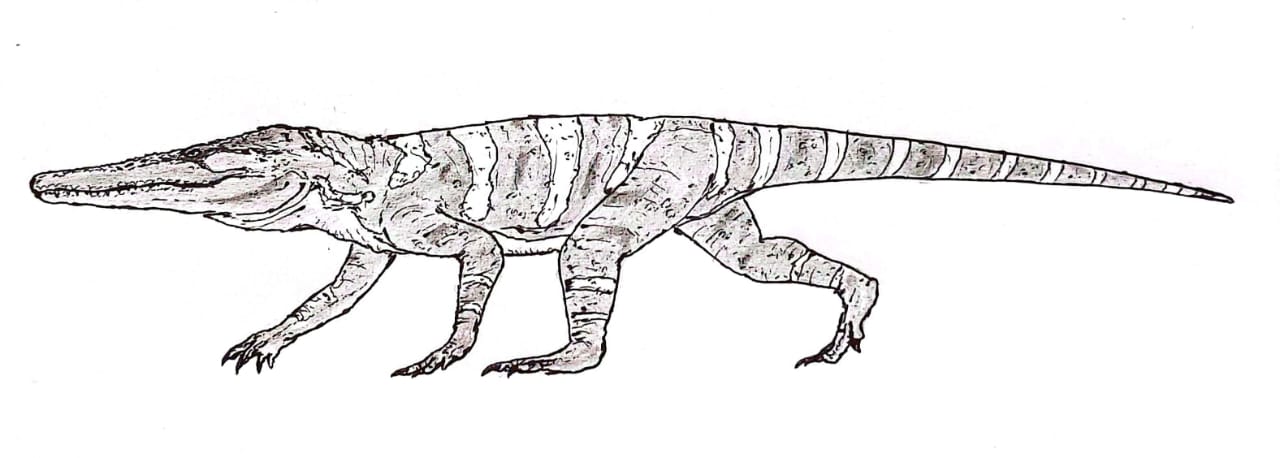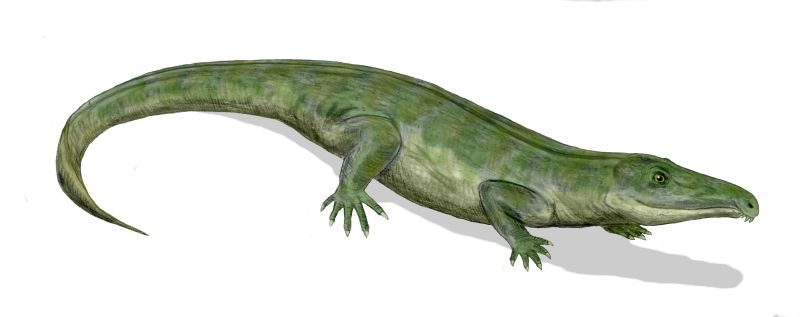|
Proterochampsa Nodosa
''Proterochampsa'' is an extinct genus of proterochampsid archosauriform from the Late Triassic (Carnian-Norian boundary) of South America. The genus is the namesake of the family Proterochampsidae, and the broader clade Proterochampsia. Like other proterochampsids, ''Proterochampsa'' are quadruped tetrapods superficially similar in appearance to modern crocodiles, although the two groups are not closely related. Proterochampsids can be distinguished from other related archosauriformes by characters such as a dorsoventrally flattened, triangular skull with a long, narrow snout at the anterior end and that expands transversally at the posterior end, asymmetric feet, and a lack of postfrontal bones in the skull, with the nares located near the midline. ''Proterochampsa'' is additionally defined by characters of dermal sculpturing consisting of nodular protuberances on the skull, antorbital fenestrae facing dorsally, and a restricted antorbital fossa on the maxilla. The genus compris ... [...More Info...] [...Related Items...] OR: [Wikipedia] [Google] [Baidu] |
Carnian
The Carnian (less commonly, Karnian) is the lowermost stage (stratigraphy), stage of the Upper Triassic series (stratigraphy), Series (or earliest age (geology), age of the Late Triassic Epoch (reference date), Epoch). It lasted from 237 to 227.3 megaannum, million years ago (Ma). The Carnian is preceded by the Ladinian and is followed by the Norian. Its boundaries are not characterized by major extinctions or biotic turnovers, but a climatic event (known as the Carnian pluvial episode characterized by substantial rainfall) occurred during the Carnian and seems to be associated with important extinctions or biotic radiations. Another extinction occurred at the Carnian-Norian boundary, ending the Carnian age. Stratigraphic definitions The Carnian was named in 1869 by Johann August Georg Edmund Mojsisovics von Mojsvar, Mojsisovics. It is unclear if it was named after the Carnic Alps or after the Austrian region of Carinthia (state), Carinthia (''Kärnten'' in German) or after th ... [...More Info...] [...Related Items...] OR: [Wikipedia] [Google] [Baidu] |
San Juan Province, Argentina
San Juan Province () is a Provinces of Argentina, province of Argentina, located in the western part of the country. Neighbouring provinces are, moving clockwise from the north, La Rioja Province (Argentina), La Rioja, San Luis Province, San Luis and Mendoza Province, Mendoza. It borders with Chile to the west. The province has an area of 89,651 km2, covering a mountainous region with scarce vegetation, fertile oases and turbulent rivers. Throughout the province there are a number of Paleontology, paleontological sites. Similar to other regions in Argentina, agriculture is one of the most important economic activities, highlighting wine production and olive oil. Additionally, a variety of fruits and vegetables are produced in the fertile valleys irrigated by artificial channels in the western part, close to the Andes mountain range. This is the second province in terms of the volume of wine production at the national level and in South America, and possesses outstanding var ... [...More Info...] [...Related Items...] OR: [Wikipedia] [Google] [Baidu] |
Secondary Palate
The secondary palate is an anatomical structure that divides the nasal cavity from the oral cavity in many vertebrates. In human embryology, it refers to that portion of the hard palate that is formed by the growth of the two palatine shelves medially and their mutual fusion in the midline. It forms the majority of the adult palate and meets the primary palate at the incisive foramen. Clinical significance Secondary palate development begins in the sixth week of pregnancy and can lead to cleft palate when development goes awry. There are three major mechanisms known to cause this failure: #Growth retardation — Palatal shelves do not grow enough to meet each other. #Mechanical obstruction — Improper mouth size, or abnormal anatomical structures in the embryonic mouth prevent fully grown shelves from meeting each other. #Midline epithelial dysfunction (MED) - The surface mucosa of embryonic shelves is impaired, which causes a failure of palatal fusion. Evolution T ... [...More Info...] [...Related Items...] OR: [Wikipedia] [Google] [Baidu] |
Nostril
A nostril (or naris , : nares ) is either of the two orifices of the nose. They enable the entry and exit of air and other gasses through the nasal cavities. In birds and mammals, they contain branched bones or cartilages called turbinates, whose function is to warm air on inhalation and remove moisture on exhalation. Fish do not breathe through noses, but they do have two small holes used for smelling, which can also be referred to as nostrils (with the exception of Cyclostomi, which have just one nostril). In humans, the nasal cycle is the normal ultradian cycle of each nostril's blood vessels becoming engorged in swelling, then shrinking. The nostrils are separated by the septum. The septum can sometimes be deviated, causing one nostril to appear larger than the other. With extreme damage to the septum and columella, the two nostrils are no longer separated and form a single larger external opening. Like other tetrapod A tetrapod (; from Ancient Greek :wikti ... [...More Info...] [...Related Items...] OR: [Wikipedia] [Google] [Baidu] |
Crocodilia
Crocodilia () is an order of semiaquatic, predatory reptiles that are known as crocodilians. They first appeared during the Late Cretaceous and are the closest living relatives of birds. Crocodilians are a type of crocodylomorph pseudosuchian, a subset of archosaurs that appeared about 235 million years ago and were the only survivors of the Triassic–Jurassic extinction event. While other crocodylomorph groups further survived the Cretaceous–Paleogene extinction event, notably sebecosuchians, only the crocodilians have survived into the Quaternary. The order includes the true crocodiles (family Crocodylidae), the alligators and caimans (family Alligatoridae), and the gharial and false gharial (family Gavialidae). Although the term "crocodiles" is sometimes used to refer to all of these families, the term "crocodilians" is less ambiguous. Extant crocodilians have flat heads with long snouts and tails that are compressed on the sides, with their eyes, ears, and n ... [...More Info...] [...Related Items...] OR: [Wikipedia] [Google] [Baidu] |
Proterosuchidae
Proterosuchidae is an early family of basal archosauriforms whose fossils are known from the Late Permian and the Early Triassic. The highest diversity of genera is known from European Russia, but fossils are also known from South Africa, India, China, Australia, Brazil and possibly Argentina. The name comes from Greek πρότερο- ("first") and σοῦχος ("crocodile"). Description They were slender, medium-sized (about long, largest specimens reached ), long-snouted and superficially crocodile-like animals, although they lacked the armoured scutes of true crocodiles, and their skeletal features are much more primitive. The limbs are short and indicate a sprawling posture, like contemporary lizards but unlike most later archosaurs. Their most characteristic feature is a distinct down-turning of the premaxilla (the front of the upper jaw, which overhangs the lower jaw). Evolutionary history The terminal Permian catastrophe, which killed off 95% of all types of life, ... [...More Info...] [...Related Items...] OR: [Wikipedia] [Google] [Baidu] |
Phytosaur
Phytosaurs (Φυτόσαυροι in Greek, meaning 'plant lizard') are an extinct group of large, mostly semiaquatic Late Triassic archosauriform or basal archosaurian reptiles. Phytosaurs belong to the order Phytosauria and are sometimes referred to as parasuchians. Phytosauria, Parasuchia, Parasuchidae, and Phytosauridae have often been considered equivalent groupings containing the same species. Some recent studies have offered a more nuanced approach, defining Parasuchidae and Phytosauridae as nested clades within Phytosauria as a whole. The clade Phytosauria was defined by Paul Sereno in 2005 as '' Rutiodon carolinensis'' and all taxa more closely related to it than to '' Aetosaurus ferratus'', '' Rauisuchus tiradentes'', '' Prestosuchus chiniquensis'', '' Ornithosuchus woodwardi'', or '' Crocodylus niloticus'' (the Nile crocodile). Phytosaurs were long-snouted and heavily armoured, bearing a remarkable resemblance to modern crocodilians in size, appearance, and lifesty ... [...More Info...] [...Related Items...] OR: [Wikipedia] [Google] [Baidu] |
Caturrita Formation
The Caturrita Formation is a rock formation found in Rio Grande do Sul, Brazil. Its sediments were deposited in the Paraná Basin. The formation is from the Upper Triassic and forms part of the Santa Maria Supersequence in the upper section of the Rosário do Sul Group. Etymology The formation received this name, because Caturrita is a neighbourhood (barrio) of Santa Maria. In Portuguese ''caturrita'' also refers to the monk parakeet. Stratigraphy The sediments of the Caturrita Formation belong to the second unit of the Santa Maria Supersequence and overlie the Alemoa Member of the Santa Maria Formation. The clayey sediments of the Alemoa Member gradually give way to the more sandy, rarely conglomeratic, Caturrita Formation, which finishes with an unconformity. After this erosional event follow the Rhaetian sediments of the Mata Sandstone, the third unit of the Santa Maria Supersequence. The Caturrita Formation was once regarded as a member of the stratigraphically higher ... [...More Info...] [...Related Items...] OR: [Wikipedia] [Google] [Baidu] |
Santa Maria Formation
The Santa Maria Formation is a sedimentary rock formation found in Rio Grande do Sul, Brazil. It is primarily Carnian in age (Late Triassic), and is notable for its fossils of cynodonts, " rauisuchian" pseudosuchians, and early dinosaurs and other dinosauromorphs, including the herrerasaurid '' Staurikosaurus'', the basal sauropodomorphs '' Buriolestes'' and ''Saturnalia,'' and the lagerpetid '' Ixalerpeton''. The formation is named after the city of Santa Maria in the central region of Rio Grande do Sul, where outcrops were first studied. The Santa Maria Formation makes up the majority of the Santa Maria Supersequence, which extends through the entire Late Triassic. The Santa Maria Supersequence is divided into four geological sequences, separated from each other by short unconformities. The first two of these sequences (Pinheiros-Chiniquá and Santa Cruz sequences) lie entirely within the Santa Maria Formation, while the third (the Candelária sequence) is shared with the ... [...More Info...] [...Related Items...] OR: [Wikipedia] [Google] [Baidu] |
Paraná Basin
The Paraná Basin (, ) is a large cratonic sedimentary basin situated in the central-eastern part of South America. About 75% of its areal distribution occurs in Brazil, from Mato Grosso to Rio Grande do Sul states. The remainder area is distributed in eastern Paraguay, northeastern Argentina and northern Uruguay. The shape of the depression is roughly Ellipse, elliptical and covers an area of about . The Paraná River, from which the Paraná Basin derived its name, flows along the central axis of the Paraná Basin and drains it. Description The Paraná Basin stretches from the Brazilian state of Mato Grosso in the north to northern Argentina and Uruguay in the south. The southern portion in Uruguay is locally known as Norte Basin.De Santa Ana et al., 2004, p.88Daners et al., 2006, p.148 Pioneer studies The first study on the Brazilian side of the Paraná Basin dates from 1841, when a Brazilian Empire, Brazilian Imperial Government Mission prospected for coal. Turning po ... [...More Info...] [...Related Items...] OR: [Wikipedia] [Google] [Baidu] |
Santa Maria Supersequence
The Santa Maria Formation is a sedimentary geological formation, rock formation found in Rio Grande do Sul, Brazil. It is primarily Carnian in age (Late Triassic), and is notable for its fossils of cynodonts, "rauisuchian" pseudosuchians, and early dinosaurs and other Dinosauromorpha, dinosauromorphs, including the herrerasaurid ''Staurikosaurus'', the Basal (phylogenetics), basal sauropodomorpha, sauropodomorphs ''Buriolestes'' and ''Saturnalia (genus), Saturnalia,'' and the Lagerpetidae, lagerpetid ''Ixalerpeton''. The formation is named after the city of Santa Maria (Rio Grande do Sul), Santa Maria in the central region of Rio Grande do Sul, where outcrops were first studied. The Santa Maria Formation makes up the majority of the Santa Maria Supersequence, which extends through the entire Late Triassic. The Santa Maria Supersequence is divided into four geological Sequence (geology), sequences, separated from each other by short Unconformity, unconformities. The first two of th ... [...More Info...] [...Related Items...] OR: [Wikipedia] [Google] [Baidu] |







